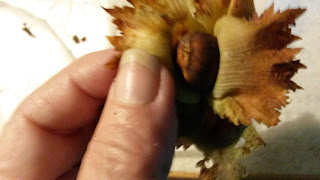The third layer of a food forest would be the shrub layer. You could have fruiting shrubs in this layer such as berry bushes, or you could have pollinator attracters in this area like barberry, honeysuckle, lilac, and cotinus. Some books also suggest having your grape and kiwi vines in this layer, however, such vines can easily climb a fruit tree and cause it serious damage or death. So, therefore, I prefer putting vines on arbors that are strong enough to hold them rather than in the food guilds (I'll explain guilds in another post).
Here is an example of a grouping of beds and arbors for vines, my first post showed this with grapevines and kiwi vines and thornless blackberry vines growing in them, but this shows the construction of the beds so they are easier to see. These beds were made with the hugelkulture system of putting logs and branches in first and filling with compost and soil. I'll talk about hugelkulture in a future post.
This tiny bed was put in a few years ago and eventually planted with blueberry plants. Blueberries require acid soil and so a separate bed was needed to provide the proper soil for them.
OK. Back to the food forest explaination.
Beneath the brighter edged of the guild where the sun reaches well under the trees, especially on the south sides are the places where you put perennial herbs, mulch plants, dynamic accumulators, beneficial insect attractors, nitrogen fixers, and possibly a few annuals. (I will talk more about each of these things in other posts).
The goals is to weave a many layered garden into a cohesive whole, each plant supporting the other plant in the guild. This configuration will extend a welcome to beneficial insects and birds to help to control any damaging insects and diseases. It will also attract other wildlife and hopefully it will be attractive to people as well.
You are trying to create an open and many layered edible woodland garden. A few tall trees in front or at the back edgee with some shrubs for hedges and berries and even to act as windbreaks for the more tender plants. Maybe a vegetable patch or a few herbs or medicinals. All totally integrated into a smooth working whole. It is very important also to maintain access to the crops to harvest them, so trails or paths are very important as well as maybe a stone or log or path to step on to go in and harvest the fruit.
The food forest goal is to have a garden where there is a nearly constant rain of fruit or nuts or other foods, to where you almost need a hard hat to walk the trails of your property. A food forest offers the biggest possible crop yields that you can have on a property as well as maximum wildlife habitat and the greatest diversity with insurance against crop failure. One crop fails but others step up to provide a different food.
Nearly every inch will be filled with greenery, fruit, flowers, herbs vines or habitat, leaving only the open parklike trails outside of the harvest. Even the trails can have some edibles growing in them such as wintergreen berries, strawberries, edible greens like dandelion and nettles.
Every month in the growing season will bring a new fruit, or nut, or vegetable, or herb, or salad green as well as teas and medicinals. And if you are into crafts you can gather branches or seed pods for them as well as flowers for your house.
Morel mushrooms grow in many of my trails and paths.
I live in Michigan that is a cold northern state and so I also have a small greenhouse. I grow my tomatoes and a few of my herbs and some other tender plants in the little greenhouse to protect them from cold, and disease from rain on the leaves. We'll talk about the greenhouse later.
So this is a basic overview of a food forest garden. I'll delve into the details in future posts.









No comments:
Post a Comment